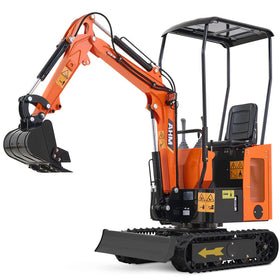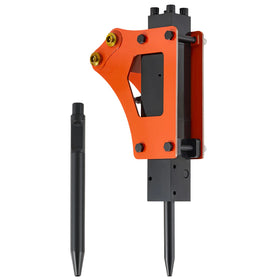Mini excavators can typically achieve digging depths of 5-6 feet, hence many consider them to be perfect for many residential and light commercial projects. Let's explore exactly what you can accomplish with these versatile machines.

1-Ton Mini Excavator Digging Capabilities
A 1-ton mini excavator strikes an ideal balance between power and maneuverability. While larger excavators might offer deeper digging depths, these compact machines excel in residential settings where space is limited. Their typical digging depth of 5-6 feet (61 to 73 inches) matches the requirements for most common residential and light commercial projects.
Popular Projects Perfect for 1-Ton Mini Excavator Digging Depth
When considering whether a 1-ton mini excavator will meet your needs, it's helpful to compare its digging depth to standard project requirements. Most residential projects fall well within these machines' capabilities:
- Drainage trenches typically need 2-4 feet of depth, well within the mini excavator's range.
- Foundation repair work usually requires 3-6 feet, making these machines ideal for most residential foundation projects.
- For garden pond installation, the standard 2-5 feet depth requirement aligns perfectly with a 1-ton excavator's capabilities.
- Even utility line installation, which typically needs 18-36 inches of depth, is easily accomplished.
When to Choose a 1-Ton Mini Excavator for Your Project

The decision to use a 1-ton mini excavator depends on several factors beyond just digging depth. These machines are ideal when you need to work in tight spaces, pass through garden gates, or minimize damage to existing landscaping. They're perfect for residential projects where larger equipment would be overkill or potentially damaging.
Key Limitations and Considerations for Mini Excavator Digging
Soil conditions significantly impact digging efficiency - loose soil allows for easier digging, while rocky or clay-heavy soil might slow progress.
Weather conditions and ground moisture also affect performance and stability during deep digging operations.
Maximizing Your Mini Excavator's Digging Performance
To achieve optimal digging depth with your 1-ton mini excavator, proper technique and preparation are essential. Positioning the machine correctly, understanding arm angles for maximum reach, and working with rather than against the terrain can help you achieve maximum digging depth safely and efficiently.
Safety Tips for Deep Digging with Mini Excavators

When pushing your mini excavator to its maximum digging depth, safety becomes paramount. Understanding stability points, recognizing soil collapse risks, and maintaining proper distances from trench edges are crucial considerations that every operator should know.
Soil conditions dramatically affect both digging safety and efficiency. Before starting, assess your soil type:
- Sandy soil requires a gentler slope angle (about 34 degrees) to prevent collapse
- Clay soil can maintain steeper walls (around 45 degrees)
- Rocky soil might need benching (creating steps in the trench wall) for stability
- Wet soil conditions require extra caution and possibly wider safety margins
For trenches deeper than 5 feet, implement these additional safety measures:
- Install trench boxes or shoring if personnel need to enter the trench
- Create a soil pile at least 2 feet back from the trench edge to prevent cave-ins
- Establish clear communication signals between the operator and ground crew
- Keep tools and materials well back from the edge to prevent them from falling in
Conclusion

By now, you should have a clear understanding of what a 1-ton mini excavator can accomplish. Consider your project requirements, space constraints, and budget to determine if this versatile machine is the right choice for your needs.







